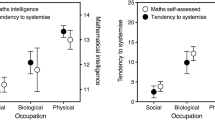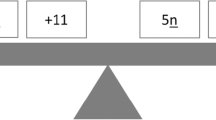Abstract
A total of 378 mathematics undergraduates (selected for being strong at “systemizing”) and 414 students in other (control) disciplines at Cambridge University were surveyed with two questions: (1) Do you have a diagnosed autism spectrum condition? (2) How many relatives in your immediate family have a diagnosed autism spectrum condition? Results showed seven cases of autism in the math group (or 1.85%) vs one case of autism in the control group (or 0.24%), a ninefold difference that is significant. Controlling for sex and general population sampling, this represents a three- to sevenfold increase for autism spectrum conditions among the mathematicians. There were 7 of 1,405 (or 0.5%) cases of autism in the immediate families of the math group vs 2 of 1,669 (or 0.1%) cases in the immediate families of the control group, which again is a significant difference. These results confirm a link between autism and systemizing, and they suggest this link is genetic given the association between autism and first-degree relatives of mathematicians.
Similar content being viewed by others
References
APA (American Psychiatric Association) (1980). DSM-III Diagnostic and Statistical Manual of Mental Disorders (3rd ed.). Washington, DC: American Psychiatric Association.
APA (American Psychiatric Association) (1994). DSM-IV Diagnostic and Statistical Manual of Mental Disorders (4th ed.). Washington, DC: American Psychiatric Association.
Baird, G., Simonoff, E., Pickles, A., Chandler, S., Loucas, T., Meldrum, D., & Charman, T. (2006). Prevalence of disorders of the autism spectrum in a population cohort of children in South Thames: The Special Needs and Autism Project (SNAP). Lancet, 368, 210–215.
Baron-Cohen, S. (2002). The extreme male brain theory of autism. Trends in Cognitive Science, 6, 248–254.
Baron-Cohen, S. (2003). The essential difference: Men, women and the extreme male brain. Penguin: London.
Baron-Cohen, S. (2006a). The hyper-systemizing, assortative mating theory of autism. Neuropsychopharmacology and Biological Psychiatry, 30, 865–872.
Baron-Cohen, S. (2006b). Two new theories of autism: Hypersystemizing and assortative mating. Archives of Diseases in Childhood, 91, 2–5.
Baron-Cohen, S., & Hammer, J. (1997). Parents of children with Asperger syndrome: What is the cognitive phenotype? Journal of Cognitive Neuroscience, 9, 548–554.
Baron-Cohen, S., Bolton, P., Wheelwright, S., Short, L., Mead, G., Smith, A., et al. (1998). Does autism occur more often in families of physicists, engineers, and mathematicians? Autism, 2, 296–301.
Baron-Cohen, S., Richler, J., Bisarya, D., Gurunathan, N., & Wheelwright, S. (2003). The systemising quotient (SQ): An investigation of adults with Asperger syndrome or high functioning autism and normal sex differences. Philosophical Transactions of the Royal Society, 358, 361–374.
Baron-Cohen, S., Wheelwright, S., Scahill, V., Lawson, J., & Spong, A. (2001a). Are intuitive physics and intuitive psychology independent? Journal of Developmental and Learning Disorders, 5, 47–78.
Baron-Cohen, S., Wheelwright, S., Skinner, R., Martin, J., & Clubley, E. (2001b). The autism spectrum quotient (AQ): Evidence from Asperger syndrome/high functioning autism, males and females, scientists and mathematicians. Journal of Autism and Developmental Disorders, 31, 5–17.
Baron-Cohen, S., Wheelwright, S., Stone, V., & Rutherford, M. (1999). A mathematician, a physicist, and a computer scientist with Asperger syndrome: Performance on folk psychology and folk physics test. Neurocase, 5, 475–483.
Baron-Cohen, S., Wheelwright, S., Stott, C., Bolton, P., & Goodyer, I. (1997). Is there a link between engineering and autism? Autism: An International Journal of Research and Practice, 1, 153–163.
Benbow, C. P., Lubinski, D., Shea, D. L., & Eftekhari-Sanjani, H. (2000). Sex differences in mathematical reasoning ability at age 13: Their status 20 years later. American Psychological Society, 11, 474–480.
Betrand, J., Mars, A., Boyle, C., Bove, F., Yeargin-Allsopp, M., & Decoufle, P. (2001). Prevalence of autism in a United States population: The brick township, New Jersey, investigation. Pediatrics, 108, 1155–1161.
Bishop, D. V. M., Maybery, M., Maley, A., Wong, D., Hill, W., & Hallmayer, J. (2004). Using self report to identify the broad phenotype in parents of children with autistic spectrum disorders: A study using the autism-spectrum quotient. Journal of Child Psychology and Psychiatry, 45, 1431–1436.
Chakrabarti, S., & Fombonne, E. (2001). Pervasive developmental disorders in preschool children. Journal of the American Medical Association, 285, 3093–3099.
Constantino, J. N., & Todd, R. D. (2005). Intergenerational transmission of subthreshold autistic traits in the general population. Biological Psychiatry, 57, 655–660.
Ehlers, S., & Gillberg, C. (1993). The epidemiology of Asperger syndrome: A total population study. Journal of Child Psychology and Psychiatry, 34, 1327–1350.
Lawson, J., Baron-Cohen, S., & Wheelwright, S. (2004). Empathising and systemising in adults with and without Asperger syndrome. Journal of Autism and Developmental Disorders, 34, 301–310.
Scott, F., Baron-Cohen, S., Bolton, P., & Brayne, C. (2002). Prevalence of autism spectrum conditions in children aged 5–11 years in Cambridgeshire, UK. Autism, 6, 231–237.
Woodbury-Smith, M., Robinson, J., & Baron-Cohen, S. (2005). Screening adults for Asperger syndrome using the AQ: Diagnostic validity in clinical practice. Journal of Autism and Developmental Disorders, 35, 331–335.
World Health Organization (WHO) (1994). International classification of diseases (10th ed.). Geneva: World Health Organization.
Acknowledgement
SBC and SW were supported by the Nancy Lurie-Marks Family Foundation and the MRC UK during the period of this work. This work was submitted in part fulfillment of the B.Sc. in Experimental Psychology, Cambridge University, by AB and EH. We are grateful to Imre Leader for discussions.
Author information
Authors and Affiliations
Corresponding author
Rights and permissions
About this article
Cite this article
Baron-Cohen, S., Wheelwright, S., Burtenshaw, A. et al. Mathematical Talent is Linked to Autism. Hum Nat 18, 125–131 (2007). https://doi.org/10.1007/s12110-007-9014-0
Received:
Accepted:
Published:
Issue Date:
DOI: https://doi.org/10.1007/s12110-007-9014-0




